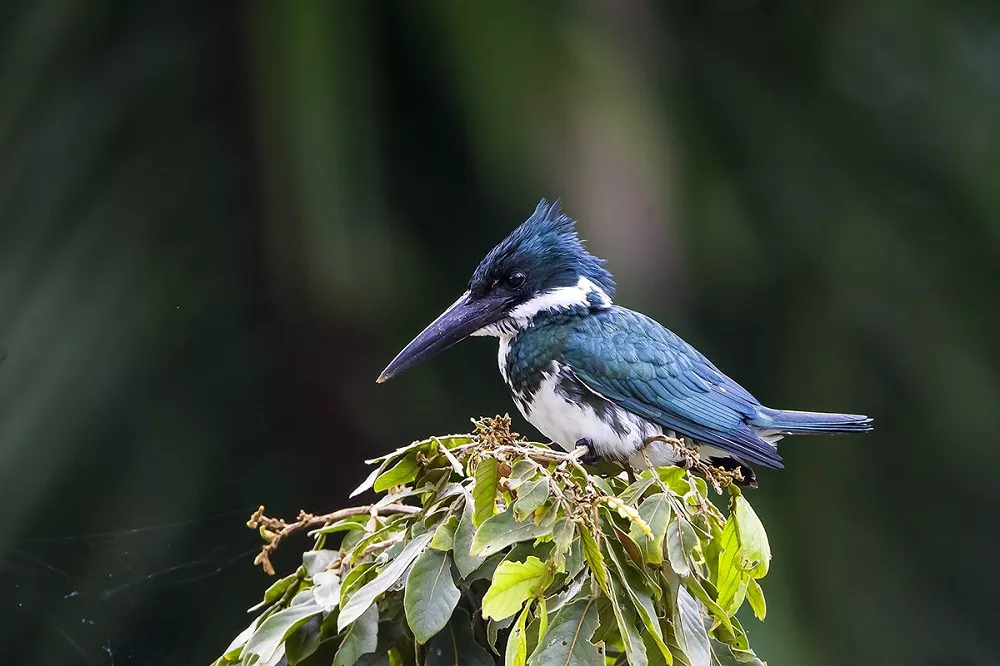The Belted Kingfisher (Megaceryle alcyon) is a captivating bird known for its remarkable fishing abilities and distinct appearance. These avian predators are native to North America and are commonly found in a variety of aquatic habitats. In this article, we delve into the diverse environments where Belted Kingfishers make their homes, highlighting their habitat preferences and the significance of these ecosystems.
Rivers, Streams, and Lakes:
Belted Kingfishers are frequently associated with freshwater habitats, including rivers, streams, and lakes. These water bodies provide essential resources for their survival. Kingfishers are particularly drawn to areas with clear, slow-moving or still waters that support abundant fish populations. They often perch on overhanging branches or snags along the water’s edge, where they can easily spot potential prey and launch their impressive dives.
Wetlands and Marshes:
Wetlands and marshes are also preferred habitats for Belted Kingfishers. These dynamic ecosystems, characterized by the presence of shallow water, emergent vegetation, and diverse aquatic life, offer abundant food sources for these birds. Kingfishers utilize the vegetation and open areas of wetlands as perches to survey their surroundings and engage in their hunting activities.
Coastal Areas and Estuaries:
Belted Kingfishers exhibit a remarkable adaptability to both freshwater and saltwater environments. They can often be observed along coastlines, estuaries, and tidal zones. These coastal habitats provide opportunities to exploit marine and estuarine fish populations. Kingfishers have been observed perching on rocks, piers, and other structures near the water’s edge, using their keen eyesight to locate potential prey.
Man-made Reservoirs and Ponds:
Belted Kingfishers are not limited to natural water bodies; they also adapt to man-made environments. Reservoirs, retention ponds, and even large garden ponds can serve as suitable habitats for these birds. As long as these human-altered water bodies offer suitable conditions, including abundant fish and suitable perching locations, Belted Kingfishers can thrive in these environments.
Nesting Burrows:
In addition to their habitat preferences for feeding, Belted Kingfishers require suitable sites for nesting. These birds excavate burrows in earthen banks near water bodies, such as riverbanks or cliffs. These burrows can extend several feet into the bank and provide a safe nesting site away from potential predators.
Geographical Distribution:
Belted Kingfishers are native to North America, with a range that spans from Alaska and Canada down to Mexico. Their distribution covers a vast territory that includes various ecosystems and habitats. However, it is important to note that Belted Kingfishers are migratory birds, with some individuals undertaking seasonal movements. In colder regions, where water bodies freeze over, they may migrate south to seek open water and more favorable hunting conditions during the winter months.
Conservation Significance:
Understanding the habitat preferences of Belted Kingfishers is essential for conservation efforts aimed at preserving these remarkable birds and their ecosystems. Protecting and maintaining healthy water bodies, wetlands, and coastal areas is crucial for ensuring the availability of suitable habitats and abundant food sources for these avian predators.
Conclusion:
Belted Kingfishers are versatile birds that inhabit a wide range of aquatic environments throughout North America. From rivers and wetlands to coastlines and man-made reservoirs, they adapt to various habitats in pursuit of their piscivorous lifestyle. By appreciating the diverse habitats where Belted Kingfishers live, we can strive to protect and conserve these ecosystems, ensuring the continued presence of these remarkable avian hunters for future generations.


 Facebook
Facebook  Instagram
Instagram  Youtube
Youtube 